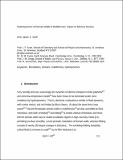Files in this item
Hydrodynamics of domain walls in ferroelectrics and multiferroics: impact on memory devices
Item metadata
| dc.contributor.author | Scott, J. F | |
| dc.contributor.author | Evans, D. M. | |
| dc.contributor.author | Gregg, J. M. | |
| dc.contributor.author | Gruverman, A. | |
| dc.date.accessioned | 2016-07-18T09:30:05Z | |
| dc.date.available | 2016-07-18T09:30:05Z | |
| dc.date.issued | 2016-07-25 | |
| dc.identifier | 244397461 | |
| dc.identifier | 6fb7a06f-bf64-4232-ab2c-a8d3eecf0ded | |
| dc.identifier | 84979735710 | |
| dc.identifier | 000381688900033 | |
| dc.identifier.citation | Scott , J F , Evans , D M , Gregg , J M & Gruverman , A 2016 , ' Hydrodynamics of domain walls in ferroelectrics and multiferroics: impact on memory devices ' , Applied Physics Letters , vol. 109 , no. 4 , 042901 . https://doi.org/10.1063/1.4959996 | en |
| dc.identifier.issn | 0003-6951 | |
| dc.identifier.uri | https://hdl.handle.net/10023/9155 | |
| dc.description.abstract | The standard "Kittel Law" for the thickness and shape of ferroelectric, ferroelastic, or ferromagnet domains assumes mechanical equilibrium. The present paper shows that such domains may be highly nonequilibrium, with unusual thicknesses and shapes. In lead germanate and multiferroic lead zirconate titanate iron tantalate domain wall instabilities resemble hydrodynamics (Richtmyer-Meshkov and Helfrich-Hurault, respectively). | |
| dc.format.extent | 4 | |
| dc.format.extent | 436847 | |
| dc.language.iso | eng | |
| dc.relation.ispartof | Applied Physics Letters | en |
| dc.subject | Ferroelastics | en |
| dc.subject | Domains | en |
| dc.subject | Multiferroics | en |
| dc.subject | Hydrodynamics | en |
| dc.subject | QC Physics | en |
| dc.subject | NDAS | en |
| dc.subject.lcc | QC | en |
| dc.title | Hydrodynamics of domain walls in ferroelectrics and multiferroics: impact on memory devices | en |
| dc.type | Journal article | en |
| dc.contributor.institution | University of St Andrews. School of Chemistry | en |
| dc.contributor.institution | University of St Andrews. School of Physics and Astronomy | en |
| dc.contributor.institution | University of St Andrews. Condensed Matter Physics | en |
| dc.identifier.doi | https://doi.org/10.1063/1.4959996 | |
| dc.description.status | Peer reviewed | en |
This item appears in the following Collection(s)
Items in the St Andrews Research Repository are protected by copyright, with all rights reserved, unless otherwise indicated.

